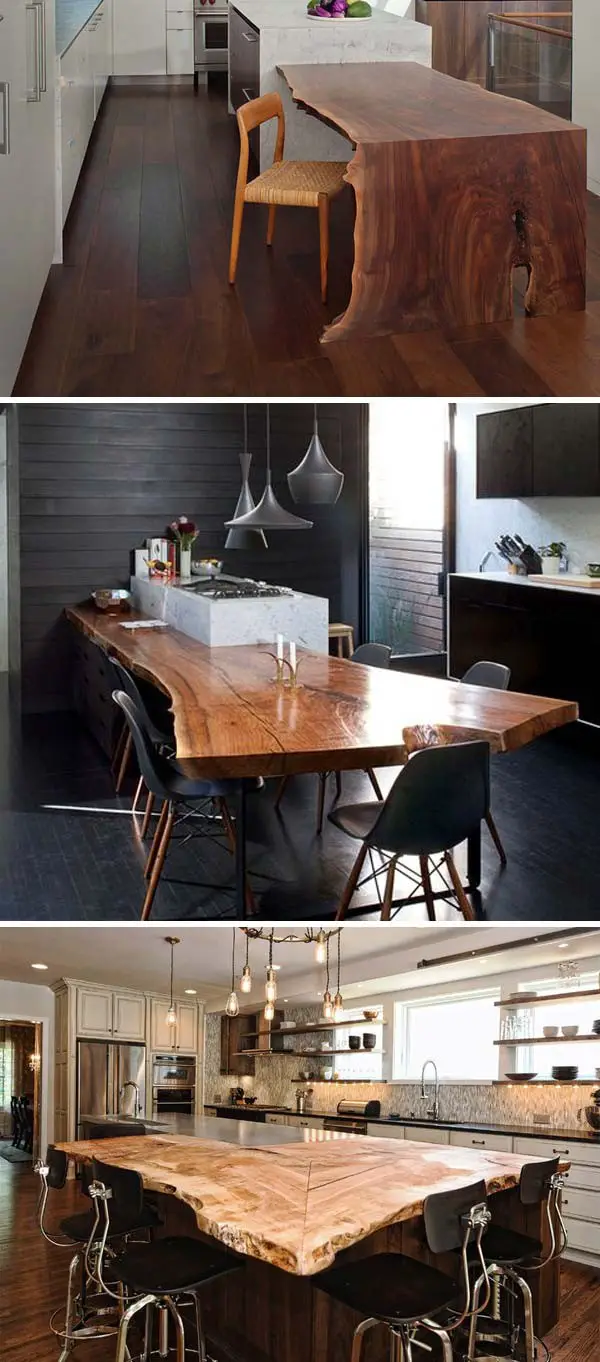Cobblestone Driveway: Cost, Installation, Pros And Cons
While it’s understandable to mistake a concrete brick driveway for a cobblestone one at first glance, there are distinct differences between the two. Cobblestone driveways are made from natural stones such as granite, limestone, or basalt, which are polished to a high shine and boast a bold, eye-catching appearance. These characteristics set them apart from concrete pavers, which may appear similar but lack the unique charm of true cobblestones.
If you’re considering installing a cobblestone driveway, it’s essential to understand its properties and requirements. This post aims to provide an overview of everything you need to know about cobblestone driveways, so continue reading for the essentials.
Types of cobblestone driveway
Cobblestone is often misunderstood as a single type of stone when in fact it can be crafted from various stone types, offering a range of colors, textures, and characteristics. When it comes to constructing a cobblestone driveway, the right choice of stone depends on factors such as traffic volume, desired aesthetic, and durability requirements. For high-traffic areas, Bluestone cobblestone with its charcoal gray palette is an excellent option.
Alternatively, Bokara cobblestone’s sandy beige color makes it suitable for courtyards, streets, and driveways that require a more subtle appearance. Buffalo granite cobblestone, with its mild-gray color and brushed finish, can add a rustic charm to any driveway. For a unique, rugged look, Gneiss cobblestone in warm gray and brown hues is an excellent choice. Italian porphyry cobblestone, with its natural stone colors and irregular shape, offers the added benefit of not staining easily.
Nile cobblestone’s rich, dark grey tone and slightly irregular shape can create a dramatic appearance. For a truly one-of-a-kind look, Reclaimed cobblestone in its various forms – including those reclaimed from old European streets – can bring a touch of history to any driveway. Sesame cobblestone, with its grey-gold finish, is an excellent option for high-traffic areas that require a durable and attractive surface.
For edging or paving purposes, Silex cobblestone in its subtle brown to chocolate brown color is an excellent choice. Tumbled limestone cobblestone, with its mottled gray color and smoother, brick-like surface, can add a touch of elegance to any driveway. Additionally, other stones like basalt and travertine can also be used for cobblestone driveways or paving.
Cobblestone driveway cost
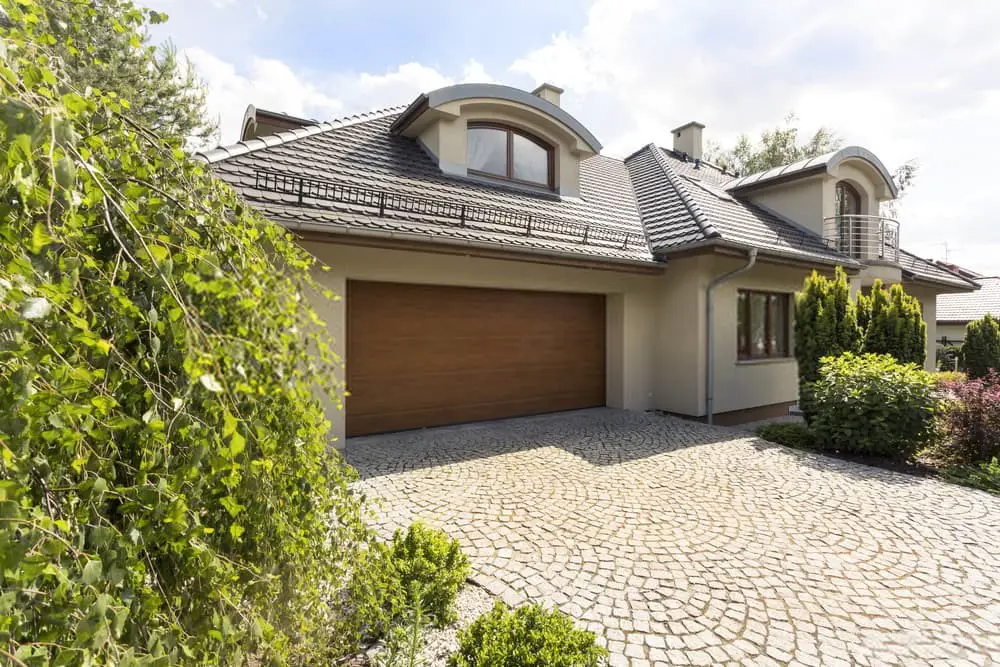
While cobblestone driveways may be visually stunning, they come with a higher price tag compared to other popular options like brick, cement, and concrete. To provide some context, let me break down the typical costs associated with installing a cobblestone driveway.
How much does it cost to build a cobblestone driveway?
When it comes to estimating the cost of building a cobblestone driveway, excluding labor costs, the price range typically falls between $12,000 and $16,000. This figure is based on a standard-sized driveway measuring approximately 640 square feet. Breaking down the cost further, the average material expense per square foot for cobblestone driveways starts at around $12.
How much does it cost to install a cobblestone driveway?
While the initial estimate may have focused on materials alone, it’s essential to consider the broader scope of costs involved in installing a cobblestone driveway. This includes labor expenses and rental equipment fees, which can significantly impact the overall installation cost. On average, homeowners can expect to pay between $14,000 to $22,000 for every 640 square feet of cobblestone driveway, depending on various factors such as location, supplier choices, and local regulations.
How much does it cost to replace a cobblestone driveway?
While brick pavers and driveways are easily replaceable, the same can be said about cobblestone driveways. Since each stone is replaced individually, it’s a relatively straightforward process. Interestingly, the average cost of replacement materials for cobblestone driveways falls within a range of $20-70 per square foot. However, this figure does not account for labor and installation expenses, which can add to the overall expense.
Cobblestone driveway pros and cons
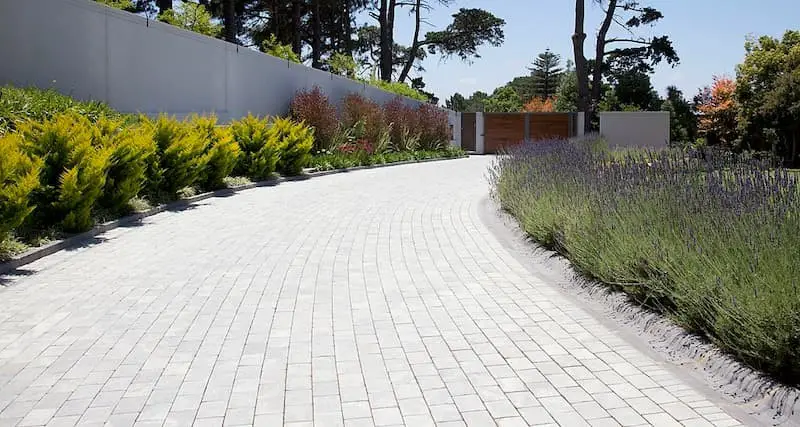
When considering a cobblestone driveway, it’s essential to weigh the advantages and disadvantages. To help you make an informed decision, let’s explore the key benefits and drawbacks of choosing this unique material for your outdoor space.
Pros
Cobblestones bring a unique aesthetic value to a home, elevating curb appeal and ultimately adding value when sold. Installation is relatively straightforward, requiring only the same level of labor as laying bricks. The option to use mortar or lay stones dry on the driveway adds flexibility to the process. One of the greatest advantages of cobblestone driveways is their unlimited design potential.
By using different types of stones, colors, patterns, and textures, homeowners can create a truly unique and personalized space. While some may view cobblestones as expensive, it’s worth noting that affordable options like limestone, basalt, and local natural stones are available. In terms of load bearing capacity, cobblestones excel, withstanding pressures up to 19,000-21,000 psi regardless of whether they’re bound with mortar or not.
This durability is matched by their weatherproofing capabilities, which allow them to absorb excess water and withstand frost and heat without compromising performance. The stones used in cobblestone driveways are also stain-resistant, thanks to their calcareous composition, making them impervious to vehicle fluids and other hazardous substances. Maintenance is a breeze, requiring only regular power washing and sweeping to keep the driveway looking its best.
In the event of damage or replacement, the process is straightforward: simply dig out the affected stones and install new ones.
Cons
When choosing cobblestone driveways, you’re making a significant upfront investment, which may not be feasible for those with limited budgets. The labor-intensive process of laying individual stones can take several weeks to complete, especially when done solo. Furthermore, the uneven surface of cobblestone driveways can lead to bumps and noise as vehicles drive over them.
Moreover, maintenance tasks like weeding and snow removal become more challenging due to the material’s patchy texture and irregular surface. These issues may prompt you to consider alternative driveway materials if you’re looking for a low-maintenance option.
Cobblestone driveway installation
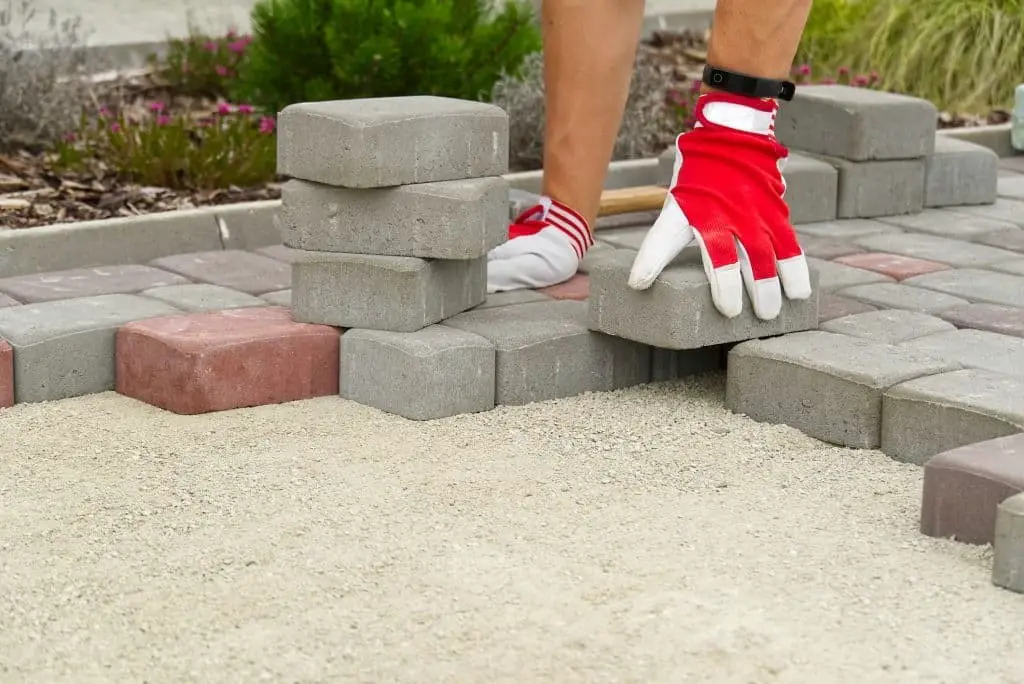
When embarking on a DIY installation of a cobblestone driveway, it’s essential to understand the process is similar to installing brick or concrete driveways. To provide a comprehensive overview, let’s break down the steps involved in preparing the surface for cobblestone installation.
The first and most labor-intensive phase is surface preparation, which includes clearing away any existing materials, tree stumps, plants by the root, and debris.
This requires using heavy machinery like sledgehammers and jackhammers. Next, mark the dimensions with stakes or nylon wires and excavate at least 7-inches of base depth. After that, lay down crushed stones around the base and compact them using a power tamper to achieve a thickness of 4.5-inches.
The subsequent step is to spread coarse sand evenly across the base using a rake and then compact it again with the power tamper.
Unlike brick installation, when laying cobblestones, start from the edge and work your way inwards, following the nylon string to maintain a linear pattern. To keep each stone in place, tap them gently with a rubber mallet. Once all stones are laid, use a garden hose to wet them and then run the power tamper again to ensure everything is even.
Before moving on to grouting or sealing, make sure the cobblestones are completely dry.
After grout has dried, give the driveway another thorough washing with a garden hose and you’re done.
Cobblestone driveway repair and maintenance
Mastering the art of cobblestone driveway care requires attention to a few key details. These pathways may be durable and low-maintenance, but they still require regular upkeep to keep them looking their best. To get started with cobblestone driveway repair and maintenance, consider the following essential tips.
Maintenance
To maintain the appearance and extend the lifespan of your cobblestone driveway, regular sweeping is a must. Every two weeks, use a standard push broom to clear off leaves, stones, and debris, paying close attention to cracked stones that may need replacement. During fall, you’ll want to increase the frequency of sweeping to ensure the surface remains free from dirt and grime. When it comes to dirt and mud, prompt removal is crucial.
Use a garden hose or power washer to scrub the surface with warm water and dish soap, then thoroughly rinse and allow it to dry before reuse. While sealing your cobblestone driveway isn’t essential, it’s highly recommended to prevent stains from gas, oil, and other fluids, as well as maintain its polished appearance and reduce wear and tear over time.
Repair
When it comes to repairing cobblestone driveways, simplicity is key. For cracked or broken stones, a straightforward approach applies: simply remove the damaged stone and replace it with a new one. Dealing with sunken areas requires a slightly different tactic. Begin by removing the affected cobblestones and then fill the base with additional gravel before reinstalled the stones. When it comes to addressing stains and discoloration, a gentle cleaning solution is all that’s needed.
A mixture of soap and warm water can effectively remove dirt and grime, leaving your driveway looking like new.
Cobblestone driveway vs asphalt driveway vs concrete
When it comes to choosing a driveway material, there are several options to consider. Among the most popular choices are asphalt, concrete, and cobblestone. To gain a better understanding of each option’s strengths and weaknesses, let’s break down their key similarities and differences.
Asphalt, concrete, and cobblestone each have their own unique characteristics that set them apart from one another.
Asphalt and concrete share some commonalities in terms of durability, with both materials capable of lasting between 10-25 years. However, when it comes to upfront costs, asphalt is generally more affordable than concrete. In contrast, cobblestone is a more expensive option upfront but can last up to 100 years.
Another key consideration is the curing time required for each material.
Asphalt and concrete both take a few days to a week to cure, while cobblestone does not require any curing time at all. When it comes to maintenance, asphalt and cobblestone are relatively low-maintenance options, whereas concrete may require more upkeep.
In terms of load capacity, cobblestone is capable of supporting the heaviest loads, with a maximum load rating of 19,000-21,000 psi. Asphalt and concrete have lower load capacities, at 15,000 psi and 11,000-15,000 psi, respectively.
Finally, installation costs vary significantly between materials. Asphalt is an easy and affordable option to install, while concrete requires more labor and expense. Cobblestone installation can be the most labor-intensive of all.
While there are many other factors to consider when choosing a driveway material, these key similarities and differences should give you a solid foundation for making your decision.
Cobblestone driveway ideas
Envisioning the perfect drive-in experience? Let’s spark some inspiration with these innovative cobblestone driveway ideas, carefully curated to transform your home’s entrance into a unique and inviting space.
Rustic chic
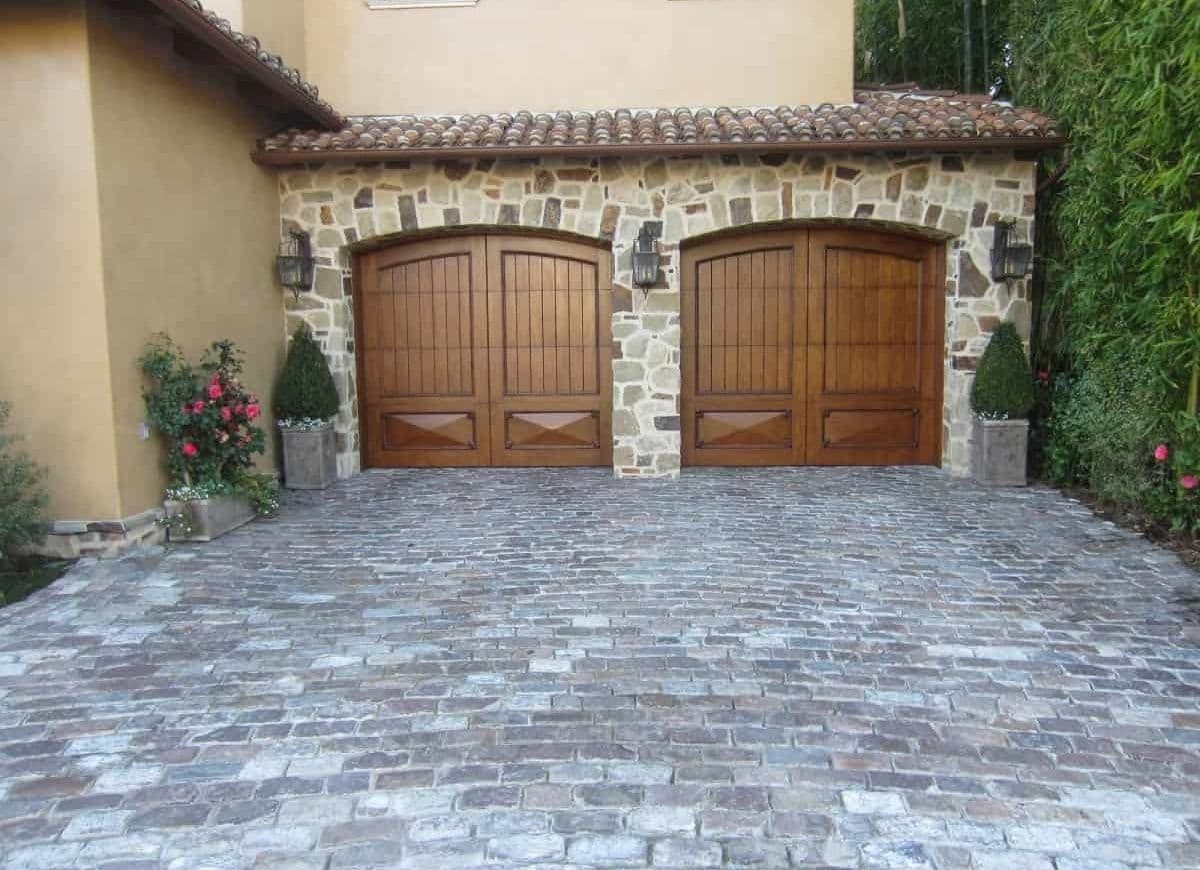
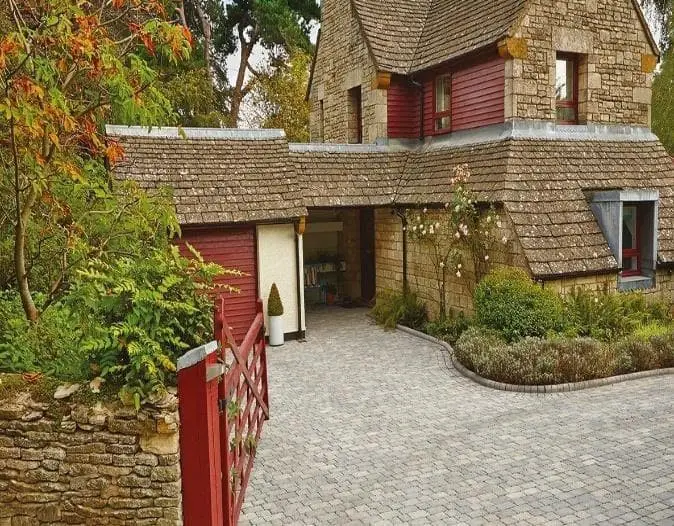
For a driveway that exudes historic charm and rustic sophistication, consider incorporating cobblestones into your design. Options like rough granite or rugged limestone or basalt offer a natural, weathered look that can be enhanced with a sand-based grout. Alternatively, you could opt for a more whimsical approach by using irregularly shaped basalt cobblestones to create a curved pathway.
Edging the driveway with the same material adds a touch of cohesion and ensures the overall aesthetic is visually appealing. This design scheme is particularly well-suited to homes featuring stone slab architecture, as it creates a harmonious visual marriage between the two.
Vintage appeal

The exterior of this classic home is perfectly harmonized with its gneiss and limestone cobblestone pavers, which seem to be straight out of a bygone era. The driveway’s lighter hues blend seamlessly with the vintage aesthetic of the property, evoking memories of decades past – specifically the 1930s or 1950s. The overall effect is one of timeless charm, as if the scene has been plucked from a nostalgic film reel and transported to the present.
Urban electric style
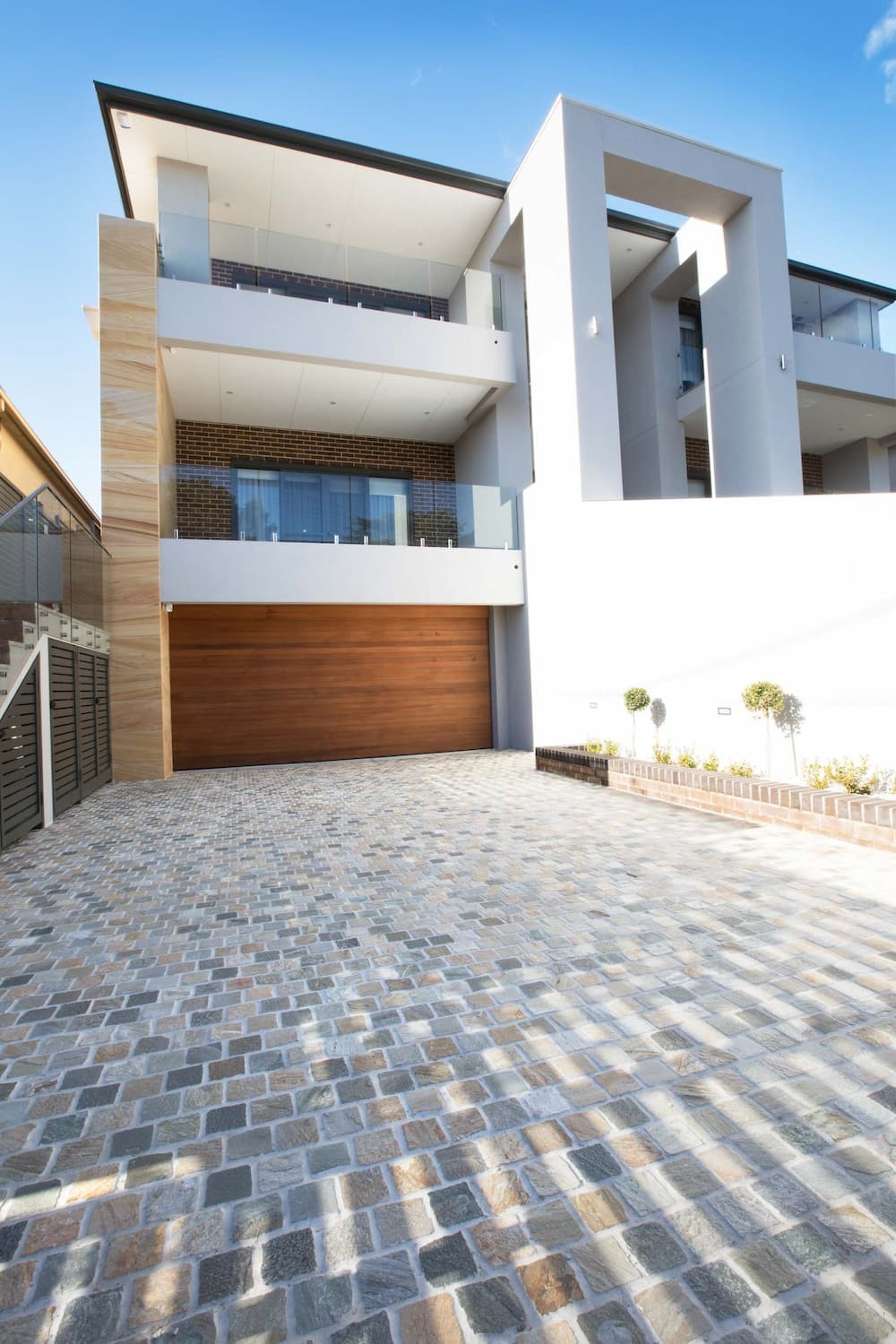
This stunning cobblestone driveway combines modern flair with warm, country charm, effortlessly sweeping you off your feet. The unique blend of bluestones and Nile cobblestones adds a touch of urban sophistication to the entrance of your home. For a striking visual effect, pair it with minimalist potted plants or let its natural beauty shine on its own. The simplicity of this design makes it an excellent choice for homeowners seeking a low-maintenance yet high-impact exterior feature.
Dynamic shapes
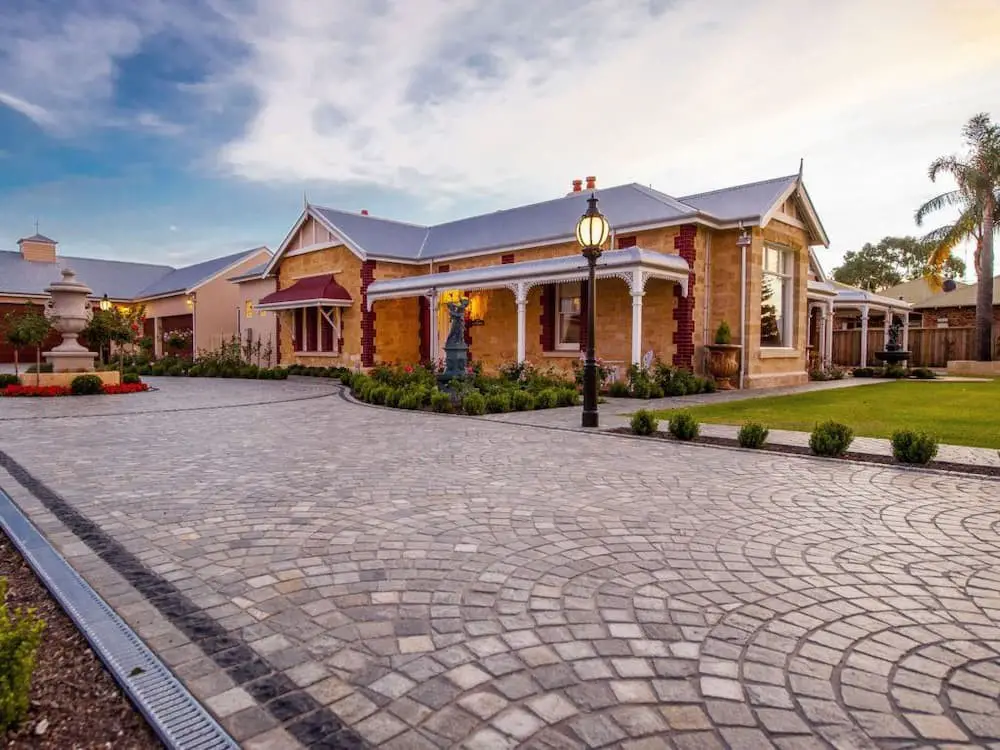
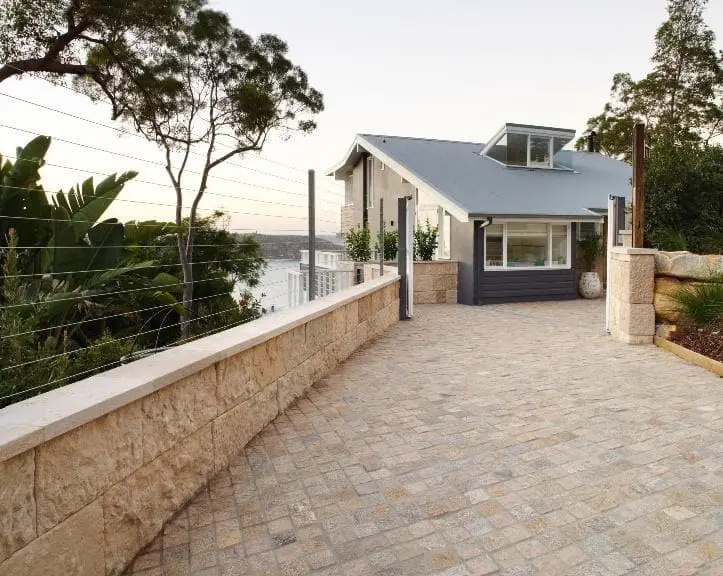
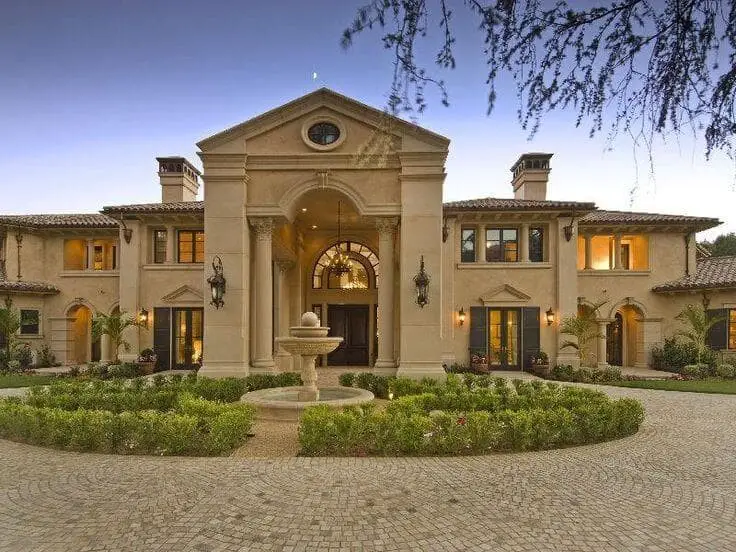
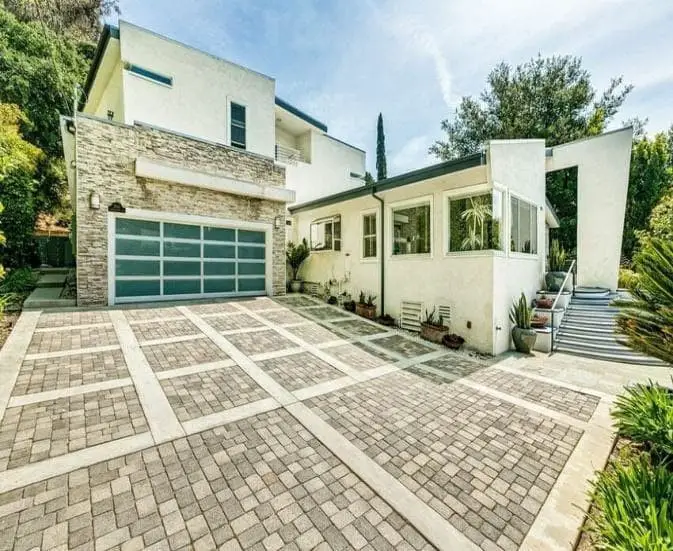
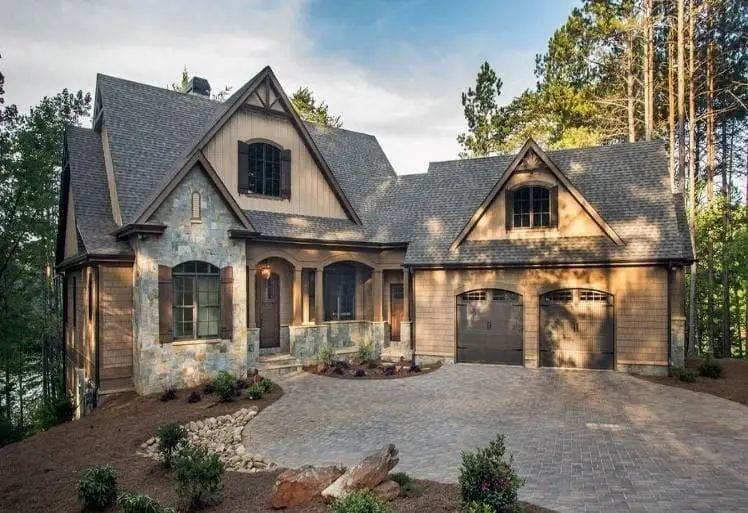
While sticking to traditional block patterns can be satisfying, you may also consider more dynamic cobblestone driveway designs. The possibilities are truly endless, allowing you to express your unique taste and style. For example, a fan-shaped cobblestone driveway with linear edging and drainage creates a striking visual effect. Alternatively, a horizontal herringbone pattern can evoke the charm of ancient courtyards and historic streets.
This design is particularly well-suited for homes that incorporate elements of Middle Eastern or Mediterranean architecture. On the other hand, a circular pattern with interlocking cobblestone panels adds a touch of sophistication to your home’s façade. The subtle tones of the cobblestones used can also introduce warmth to the overall aesthetic.
If you prefer a cleaner, more minimalist look, consider combining cobblestones with basalt and terra cotta for a geometric design that complements modern, industrial, or minimalist style homes.
Sealed and polished
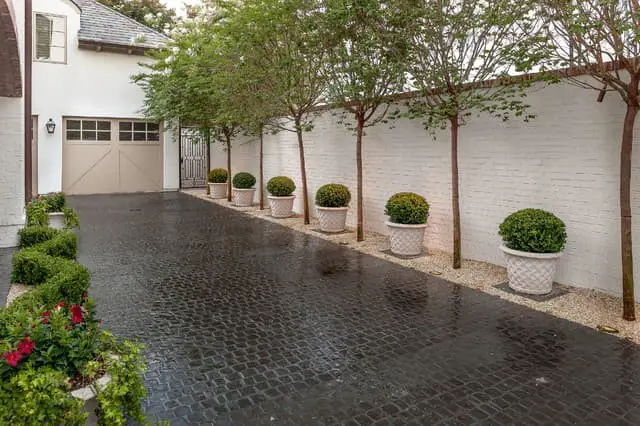
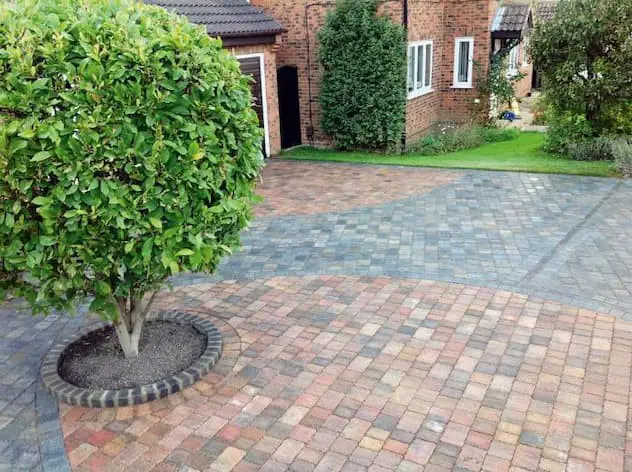
For a driveway that exudes a warm, radiant glow during the summer months, consider opting for a polished sealed cobblestone finish. This look is particularly striking for seasonal homes in colder climates. The stability of the cobblestone pavers is attributed to the epoxy grout, which not only ensures a low-maintenance driveway but also inhibits weed growth and allows snow to be easily thawed.
This feature-rich design is further enhanced by its dark, rich tones, which provide a beautiful contrast to bright-colored homes while also concealing leaks from oil, gas, and other vehicle fluids. The versatility of cobblestone pavers also allows for a multi-hued palette, as seen in this example featuring warm silex tones paired with cooler buffalo and bluestone hues.
The circular pattern and use of live edging, including turf grass and carefully curated shrubs, evoke a classic European charm that is sure to turn heads.
FAQs
How many cobblestones do I need to build a driveway?
To determine the required quantity of cobblestones, contractors often rely on a simple formula: one square foot of space needs approximately four cobblestones. To apply this rule, start by calculating the total area of your driveway, which is simply the length multiplied by the width. Then, multiply that total area by 4 to arrive at the number of cobblestones you’ll need for the project.
How long do cobblestone driveways last?
Cobblestone driveways have an unparalleled reputation for enduring the test of time, with some examples remaining structurally sound for centuries. The fact that contractors continue to utilize reclaimed cobblestones from ancient European towns and the Middle East is a testament to their remarkable durability and longevity.
This level of stability is a direct result of the careful craftsmanship and natural weathering process that cobblestones undergo over the years, making them an attractive option for homeowners seeking a long-lasting and low-maintenance driveway solution.
Conclusion
In reality, cobblestones are more than just visually appealing and high-end additions to driveways – they’re also smart investments in the long haul. On one hand, their timeless charm provides an unbeatable selling point for your property over the years. Furthermore, cobblestone driveways boast impressive durability and load-bearing capabilities. On the other hand, they are surprisingly easy to maintain and repair.
When you weigh these benefits against the initial costs and installation process, it’s clear that cobblestones truly offer value that far surpasses their upfront expenses. With this understanding, choosing a cobblestone driveway should now be a more informed decision.
Related Posts
To thrive in the agricultural industry, farm businesses require reliable and high-quality equipment. A well-maintained tractor, for instance, can significantly impact crop yields and overall efficiency. However, with so many options available, selecting the right equipment for your specific needs can be a daunting task. To make an informed decision, it’s essential to consider factors such as budget, climate, and land topography.
Additionally, choosing equipment that is durable, easy to maintain, and adaptable to changing circumstances will ensure long-term success. By prioritizing these key considerations, farmers can confidently invest in the right equipment to drive their business forward. Meanwhile, homeowners seeking to enhance curb appeal may be wondering what color garage door complements a yellow house or a green house. The answer lies in finding harmonious colors that create a visually pleasing contrast.
For example, a warm beige or light gray garage door can create a striking combination with a yellow house, while a deep blue or forest green garage door can provide a sophisticated pairing with a green house. Ultimately, the key is to strike a balance between aesthetics and functionality. By choosing the right colors, homeowners can create a welcoming and inviting exterior that reflects their personal style.
Lastly, it’s essential to consider the etiquette surrounding gratuities for home services like driveway sealing. While tipping is not always expected, it’s crucial to show appreciation for professionals who go above and beyond in their work.




